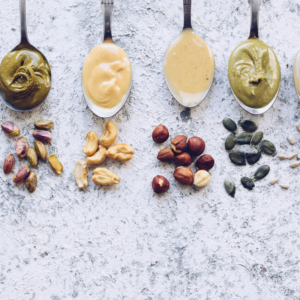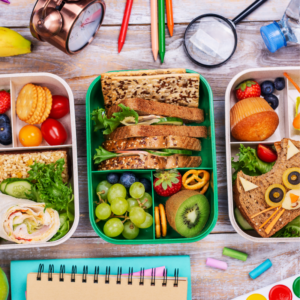As parents of neurodiverse kids, we know that proper nutrition can significantly impact our children’s ability to focus, learn, and manage their emotions throughout the school day. However, packing a nutritious lunch that meets their unique needs and likes can be quite a challenge. With food sensitivities, picky eating habits, and sensory issues often in the mix, finding the right balance is key. In this blog, I’ll share practical tips and tools for packing lunches that not only fuel your child’s body but also support their academic success.
A well-balanced lunch can help regulate energy levels, support concentration, and improve mood—all crucial for a successful school day. Many neurodiverse children have specific dietary needs or restrictions, such as sensitivities to gluten or an aversion to certain textures and flavors. For these kids, lunchtime is an opportunity to provide essential nutrients that might be missing from their diet due to sensory preferences or restricted eating habits. As Pamela Compart, co-author of "The Kid-Friendly ADHD & Autism Cookbook", highlights, many children on the spectrum and ADHD have sensitivities to certain foods like gluten, which can impact both their physical and emotional well-being.
By thoughtfully preparing lunchboxes that cater to these needs, we can help our kids feel more comfortable and focused during the school day. Here are some strategies that have worked well for me and could be game-changers for you too!
1. Swap Sugary Snacks with Healthier Alternatives:
Sugar can significantly affect behavior, attention, and mood, especially in neurodiverse children. Instead of packing sugary snacks, consider healthier alternatives that still offer a satisfying taste.
- Mightylicious Cookies: These gluten-free cookies are a great alternative to regular cookies. They are low in sugar and made with wholesome ingredients that cater to children with gluten sensitivities. Plus, they taste great, which means you won’t have to struggle to get your child to eat them. My picky eater tried these cookies and loved them. Even my oldest who usually does not like anything labeled " Gluten free".

- Whole Fruit and Dried Fruit (without added sugar): Fruits are naturally sweet and packed with vitamins, making them a perfect snack. Try apple slices, grapes, or dried apricots to replace sugary treats. I know its tempting to grab the fruit snacks, but try making them at home with the kids instead.
- Nuts and Seeds: If your child’s school allows, nuts and seeds can be a fantastic source of protein and healthy fats. Almonds, cashews, or sunflower seeds can be a crunchy and satisfying alternative to chips.

2. Incorporate Nutrient-Dense Foods:
Including foods rich in essential nutrients like zinc, magnesium, and omega-3s can help support cognitive function, emotional regulation, and overall health.
- Sandwiches with a Twist: Instead of regular bread, use whole grain or gluten-free options, and spread seed or nut butter for added protein and healthy fats. Add sliced bananas or honey for a sweet twist. In my house my picky eater loves nut butter and honey but he does not like when the honey gets on his fingers. I like to mix the honey and nut butter and place it in a container in his lunch box for him to make his own sandwiches.

- Colorful Veggie Wraps: Use gluten-free wraps and fill them with lean proteins like turkey or chicken, along with colorful veggies like bell peppers, spinach, and shredded carrots. Add hummus or a mild guacamole for flavor and creaminess. Some kids may not like the texture of raw veggies so consider shredding them up to a fine texture.
- Quinoa Salad: Quinoa is a gluten-free grain high in protein and fiber. Combine it with diced veggies, beans, or chicken, and a light dressing. This is a great option for kids who prefer bite-sized, easy-to-eat meals.
3. Use Tools to Make Healthy Eating More Appealing:
Making food fun and visually engaging can encourage neurodiverse kids to try new things and eat healthier options.
- UVI Self-Heating Lunchbox: My son will only eat real food when it's fresh or warm. For kids who prefer warm meals, this self-heating lunchbox is a game-changer. You can send leftovers, soups, or other warm meals, and the lunchbox will heat it up just in time for lunch, making it more appealing and easier to eat.

- Bento Boxes: Bento boxes with compartments can be great for portion control and variety. Fill each compartment with different textures and colors to make the meal visually interesting. Include a mix of proteins, carbs, fruits, and veggies to cover all nutritional bases.

Getting kids to drink enough water can be challenging, especially if they prefer sugary drinks. But staying hydrated is vital for maintaining focus and energy levels throughout the day.
- Carbon8 Sparkling Water Maker: If your child isn’t a fan of plain water, the Carbon8 sparkling water maker can turn regular water into bubbly, fun drinks. Add a splash of natural fruit juice or some fruit slices to make it even more enticing without the sugar rush.

- Flavored Water Bottles: Encourage your child to drink more water by adding slices of cucumber, lemon, or berries to their water bottle. This adds a refreshing taste without the sugar found in sodas or juice boxes.
Planning lunches in advance can help reduce the morning chaos and ensure your child gets a balanced meal every day. It's also nice to ask your child to help you. This will get your child excited about trying new things and they can learn how to make their own lunches. Here’s a simple example of a weekly lunch meal plan that’s both nutritious and appealing:
- Monday: Turkey and avocado wrap, apple slices with cinnamon, carrot sticks with hummus, and a bottle of sparkling water with lemon.
- Tuesday: Quinoa salad with black beans, corn, and grilled chicken, gluten-free crackers, orange segments, and a mixed nut and seed pack.
- Wednesday: Gluten-free pasta with marinara sauce, steamed broccoli, Mightylicious cookie, and cucumber slices with a yogurt dip.
- Thursday: Chicken and veggie skewers, gluten-free pita with tzatziki sauce, a small bunch of grapes, and a fruit-infused water bottle.
- Friday: DIY bento box with gluten-free rice balls, edamame, cherry tomatoes, apple slices, and a small container of trail mix.
Packing nutritious, neurodiverse-friendly lunches doesn’t have to be overwhelming. With a bit of planning and creativity, you can provide your child with meals that support their learning, mood, and overall well-being. Remember, small changes can lead to big improvements over time, so don’t be afraid to experiment with different foods and tools to find what works best for your child. Make these changes for the entire family not just your neurodiverse child. This will create healthy eating habits for the entire family.
Feel free to checkout my Kid's Meals Pinterest filled with more recipes and lunch-packing tips specifically designed for neurodiverse kids! Let’s work together to make this school year the best one yet. Share your favorite lunch-packing tips and tricks in the comments below, and let’s support each other on this journey!
Houzzmagazine There is definately a lot to find out about this subject. I like all the points you made